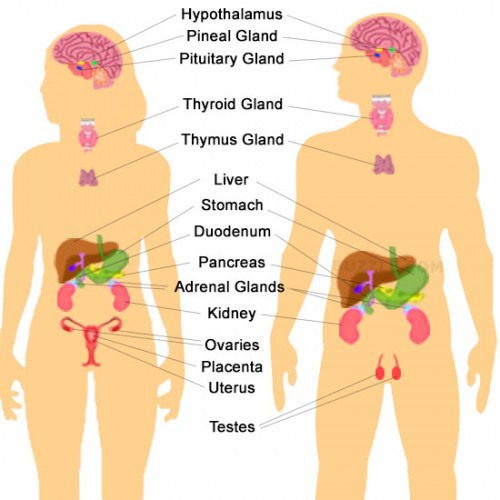 The Thyroid Gland is a butterfly-shaped gland Ƹ̵̡Ӝ̵̨̄Ʒ located in your neck just above your collar bones. It is part of the Endocrine system, a group of glands in the body responsible for hormone secretion.
The Thyroid Gland is a butterfly-shaped gland Ƹ̵̡Ӝ̵̨̄Ʒ located in your neck just above your collar bones. It is part of the Endocrine system, a group of glands in the body responsible for hormone secretion.
The Endocrine system consists of many ductless glands which secrete hormones within our bodies as shown in the diagrams below:

Endocrine Systems
The secretion of these hormones is vital to the health of the overall body and this secretion is responsible for tissue growth, mood, metabolism, temperature, etc.
Typical endocrine glands are the thyroid (3), adrenal glands (5), pituitary gland (2) Thymus (4) and in females the ovaries (7) although there are many others.
Thyroid Hormone Regulation- the Chain of Command
 The thyroid itself is regulated by another gland located in the brain, called the pituitary. In turn, the pituitary is regulated in part by the circulating thyroid hormones (via the “feedback” effect of thyroid hormone on the pituitary gland) and by another gland called the hypothalamus.
The thyroid itself is regulated by another gland located in the brain, called the pituitary. In turn, the pituitary is regulated in part by the circulating thyroid hormones (via the “feedback” effect of thyroid hormone on the pituitary gland) and by another gland called the hypothalamus.
The hypothalamus releases a hormone called thyrotropin-releasing hormone (TRH), which sends a signal to the pituitary gland to release thyroid stimulating hormone (TSH). In turn, TSH sends a signal to the thyroid to release thyroid hormones. If overactivity of any of these three glands occurs, an excessive amount of thyroid hormones can be produced, thereby resulting in hyperthyroidism. Similarly, if underactivity of any of these glands occurs, a deficiency of thyroid hormones can result, causing hypothyroidism.
 The rate of thyroid hormone production is controlled by the pituitary gland. When the pituitary senses an insufficient amount of thyroid hormone circulating in the blood, the pituitary gland releases TSH in an attempt to stimulate more thyroid hormone production by the thyroid. In contrast, when excessive amounts of thyroid hormones circulate, in the blood, the TSH level falls in order to decrease the production of thyroid hormones. Specific cells in the thyroid produce another hormone called calcitonin. Unlike T3 and T4, calcitonin is not involved in the regulation of metabolism. Calcitonin regulates calcium by lowering calcium levels in the blood. Excess calcium in the blood is referred to as hypercalcemia.
The rate of thyroid hormone production is controlled by the pituitary gland. When the pituitary senses an insufficient amount of thyroid hormone circulating in the blood, the pituitary gland releases TSH in an attempt to stimulate more thyroid hormone production by the thyroid. In contrast, when excessive amounts of thyroid hormones circulate, in the blood, the TSH level falls in order to decrease the production of thyroid hormones. Specific cells in the thyroid produce another hormone called calcitonin. Unlike T3 and T4, calcitonin is not involved in the regulation of metabolism. Calcitonin regulates calcium by lowering calcium levels in the blood. Excess calcium in the blood is referred to as hypercalcemia.
Thyroid Disease 101:
- The thyroid is a gland shaped like a butterfly and located in the front of the neck, just below the Adam’s apple.
- The gland wraps around the windpipe (trachea), and its shape resembles a butterfly formed by two wings (lobes) attached by a middle part (isthmus).
- The thyroid gland works like a factory that uses iodine (mostly from the diet in foods such as seafood and salt) to produce thyroid hormones.
- These hormones help to regulate the body’s metabolism and affect important processes, such as growth and other metabolism of the body.
- The two most important thyroid hormones are thyroxine (T4) and triiodothyronine (T3), representing 99.9% and 0.1% of thyroid hormones, respectively.
- The hormone with the most biological power is T3. Once released from the thyroid gland into the blood, a large amount of T4 is converted to T3 – the active hormone that affects the metabolism of all cells. Depending on the underlying issues, a diagnosis might be made after blood tests, biopsy and/or imaging. (Full Thyroid Panel is always necessary)
Possible TRIGGERS:
- Viral, bacterial, or Candida infections as a trigger or as a direct cause
- Ongoing stress, sufficient to cause adrenal insufficiency that hampers conversion of T4 to T3 and weakens the body’s immune defenses
- Pregnancy, wherein hormonal and immune system shifts can trigger Hashimoto’s in susceptible women either during pregnancy or postpartum
- Trauma, such as surgery or an accident
- Nutrient deficiencies, in particular of iodine and/or selenium
- Foodborne bacteria, most notably Yersinia enterocolitica, though this is more common outside the U.S. (Shomon, 2001)
Toxins are of particular concern, especially those created from petrochemicals. Many plastics (all those bottles of water we drink), pesticides, fertilizers, dioxin, body care products, not to mention what’s in the air and tap water we ingest, all contain substances that mimic our own body’s estrogen. These xenoestrogens are powerful endocrine disruptors, affecting the balance of all our hormones, and are thought to contribute to the rise in autoimmune conditions in general (Plapp, 2002) and to Hashimoto’s thyroiditis specifically (Shames, private conversation; May, 2007). Mercury (from fish and dental amalgams) and fluoride (in toothpaste and water) are also endocrine disruptors. Mercury amalgams, especially, since they sit so close to the throat, can pose a serious threat to the thyroid gland, making mercury detoxification imperative (Bauman, in Shomon, n.d.). [1]
Click here for more information on the Thyroid Gland.

